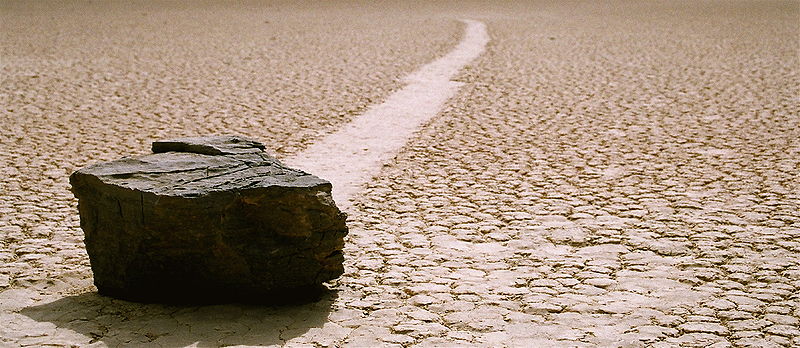Ok, forget the scissors and paper - this article is about rocks
and custard.
The Sliding Rocks Of Racetrack Playa
Racetrack Playa is a dry lake bed in Death Valley National Park. It is famous for its sliding rocks. Theories that the rocks have been moved by people or animals have been ruled out. These rocks move according to some as yet unknown natural mechanism.

Image source: Wikimedia, Tahoenathan, GNU.
The sliding rocks are few in number and are found mainly in the southeast.
Examination of trail patterns shows an inferred general trend in rock movement toward the north-northeast (Figure 3).This is consistent with the direction of prevailing winds. However, there is a high degree of variation in trail character. Surprisingly, trail lengths and headings are not well correlated with rock shape, volume or area of surface contact.
...
...
...
Terrain analysis of the surrounding basin quantifies the influence of topography on inferred airflow, which ultimately governs the nature and magnitude of sliding rock episodes.
http://www.nature.nps.gov/geology/usgsnps/deva/ftracPM.html
It is highly likely that the rocks are moved by winds. However, the exact mechanism remains unknown.
A tentative theoretical mechanism for rock movement.
The dried out surface of the playa has a fairly rough texture. It is improbable that any wind normal for the area could cause a rock to slide over such a surface. On the assumption that wind is the cause of sliding one must seek a natural means by which the surface may be so modified as to permit sliding.
Mud is notoriously slippery. A specific type of mud is used as a lubricant in the drilling of boreholes. However, I suggest that the stones do not simply slide on mud during or after rainfall.
I suggest that a small quantity of rain over the region could amount to enough rain in a shallow flash flood to produce anything from about a half to two inches of very liquid mud. If the mud behaves as a non-newtonian liquid then that is sufficient to explain the observed tracks.
As mud flows over the surface, or as the mud liquifies from the top down, it can act as a lubricant. A strong enough wind can cause some stones to move. Even as the depth of liquid mud is increasing a moving stone may continue moving along the surface. If a lull allows a stone to stop moving it will sink into the mud and the depth to which it sinks will determine whether or not the next gust of wind will cause movement.
The trail left by a rock in a non-newtonian fluid will be heavily damped. It will not form an angular bow wave, nor will it form a spreading stern wave. The wave will be parallel to the path of motion. The waves on either side of the depression made by the rock will dissipate very slowly.
In a short-duration flash flood followed by intense sunshine the displaced fluid will not have time to settle much, but will be dried in situ. The resulting debris trails either side of the rock's path will show the slump angle of dried material and will appear to have formed in a dry condition.
Conclusions:
If the Racetrack Playa rocks slide on a non-newtonian fuid surface during brief intervals of rain then evidence of this should be observable in the trails.
The trails will show angular discontinuities of direction.
Over any small enough area the distances that rocks move between contemporaneous discontinuities will be highly correlated.
At any past point of rest, whether or not at an obvious geometric discontinuity, there should be some evidence of spoil transverse to the track.
---------------------
Further reading:
http://geology.com/articles/racetrack-playa-sliding-rocks.shtml
http://www.nature.nps.gov/geology/usgsnps/deva/ftracPM.html
-------------------
Related - but only just :)
Custard: a non-newtonian fluid.





Comments